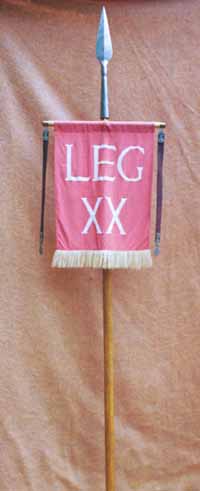 |
Each century in a cohort
had a
signum or battle standard. It was carried by the signifer, who
wore
a bear or wolf pelt over his helmet and hanging down his
back.
Just what the various discs and crescents indicated is unknown; there
is
a theory that the number of discs (phalerae) corresponds to the
century's number
in
the cohort, but this is contradicted by a signum shown on Trajan's
Column
with seven discs. There is also a scene of two signa standing
side
by side, each with five discs--they should be in different parts of the
camp if they represent the 5th century of different cohorts. (And
in any case, centuries were not numbered but were known by their
centurions'
titles, e.g. hastati priores, etc.) The discs may indicate the
number
of the cohort, or they may be unit awards for valor, or they may have
some
other meaning entirely.
Other objects that may
appear on
the signum include wreaths, plaques with unit nomenclature, images of
the
emperor, and animal totems. At the top was either a simple
spearhead
or a hand, possibly a tradition dating back to the maniple or
"handful",
a unit of two centuries. Many depictions show a pair of "handles" on the bottom part of the pole. These are actually foot steps, for driving the signum into the ground. The vexillum was a small banner carried by any detached part of a legion. It was also used as a cavalry standard. One original vexillum has been found, red linen painted with a figure of Victory standing on a globe (seen in Connolly's book). In Roman artwork, any vexillum which isn't just blank (due to loss of painted detail) has only lettering on it. Our vexillum is red
silk with painted
letters, about 12" by 16". At the top the fabric is turned down
to
form a sleeve, and there's a notch cut in the sleeve at the middle of
the
back. On the pole is a simple brass strip formed into loop--that
goes into the notch, and a wood dowel crossbar goes through the sleeve
and the loop. A removable pin through the loop and into the
crossbar
keeps it from sliding around. Much of this construction is simply
guesswork because none of these details survive. Some
depictions
show cords running from the ends of the crossbar up to the finial
(usually
a spearhead). The fringe is white wool yarn. |
 |
 |
Detail showing the back of the hand and its loops. The upper loop
is simply a strip of brass formed into a ring and soldered in
place. Small nails go through the overlapped ends into the
pole. The lower loop is formed by the base of the hand itself,
and is pierced through for the brass tube which forms the
crossbar. Note that this is all completely conjectural!
There are many possible ways to assemble all the parts, since there is
so little solid evidence. |
 |
Detail of the back of the crescent and a disc. The crescent is
secured by a loop or band just like on the hand. The square nut
securing the disc is visible, and the end of the bolt is peened over it
like a rivet. Note that the threads of the bolt would have been
visible between the pole and the back of the disc, so they are covered
by a short piece of brass tubing. |
 |
One way to attach the dangling strips to the crossbar. A U-shaped
"staple" of brass wire is inserted into two small holes in the bottom
of the brass tube, and the ends bent over inside. The tab on the
upper strap end simply hooks through that. Better to rivet the
end of that tab down (by means of one or both rivets), to prevent it
coming loose. A finial of some sort would give a more finished
look to the crossbar, and of course it might be nice to keep it
cleaner.... The straps themselves are very similar to the apron
on the military belt. |
Every legion had its aquila, or eagle standard, carried by the aquilifer. It may have been hollow-cast bronze or silver with gold plating, or maybe worked from gold or gilded silver sheet. Another standard called the imago was a small bust of the emperor. Legio XX does not yet have an aquila, though Legio XXIV and several other units do.
When not being carried, the unit's standards were stored in a special shrine in the principia or headquarters building. They were considered to be sacred objects, and sacrifices were made to them. The loss of any standard in battle, particularly the aquila, was the worst possible disgrace for a unit.
